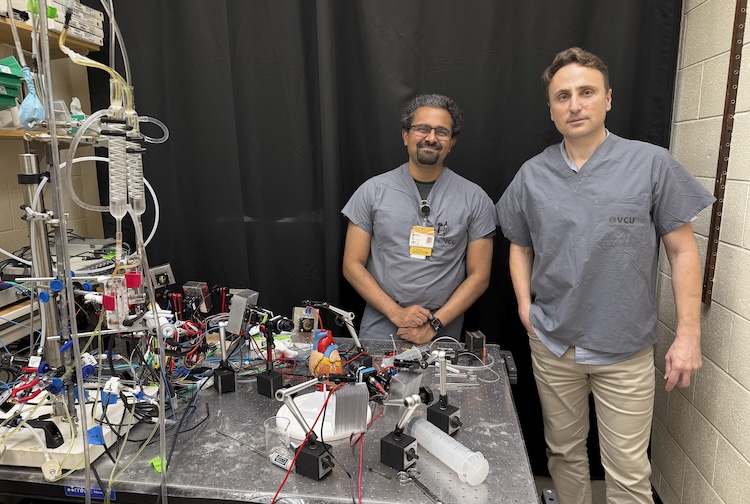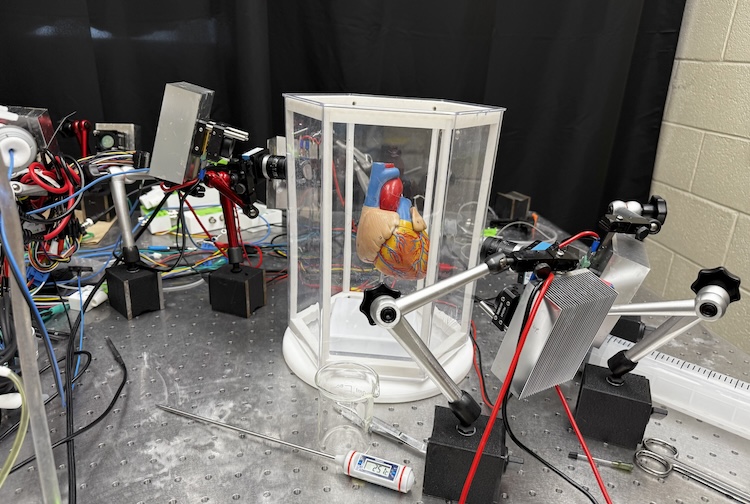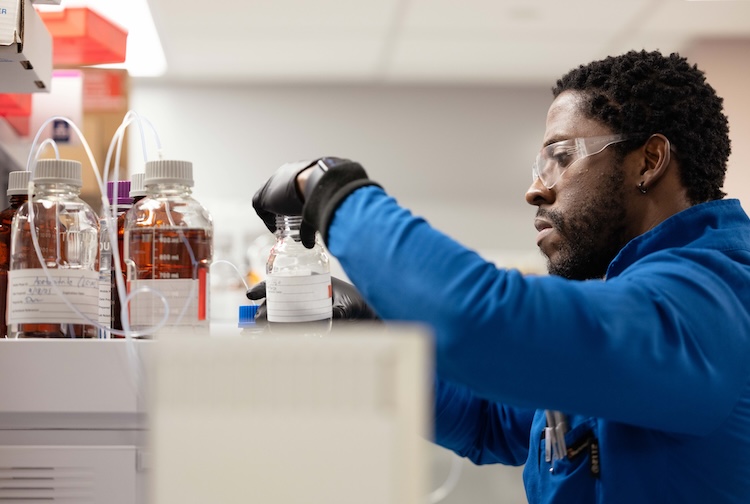VCU innovators look to streamline pacemaker procedures and safety
University grants fuel two clinical tools created to improve implantation accuracy and device management.
August 20, 2025 Ajay Pillai, M.D. (left), and Ilija Uzelac, Ph.D. (right), have teamed to develop SurePace, an AI-powered pacemaker placement system. They recently received a Commercialization Fund grant from VCU TechTransfer and Ventures. (Contributed by John Battiston)
Ajay Pillai, M.D. (left), and Ilija Uzelac, Ph.D. (right), have teamed to develop SurePace, an AI-powered pacemaker placement system. They recently received a Commercialization Fund grant from VCU TechTransfer and Ventures. (Contributed by John Battiston)
By John Battiston
A pair of innovations by Virginia Commonwealth University researchers are making headway in two critical areas of pacemaker care: how devices are implanted, and how they are managed during surgery. Both innovations have received support from VCU TechTransfer and Ventures, a division of the VCU Office of the Vice President for Research and Innovation.
SurePace: AI software for pacemaker placement
Thanks to a $40,000 Commercialization Fund grant from the office, Ajay Pillai, M.D., and Ilija Uzelac, Ph.D., are developing SurePace, an artificial intelligence system designed to simplify the emerging technique of left bundle branch area pacing, also known as LBBAP. The procedure, though promising, is notoriously difficult to get right — and inaccuracy can negate the potential benefits for patients with heart failure.
“Conventional pacemakers can result in heart failure up to 25% of the time,” said Pillai, an electrophysiologist at VCU Health Pauley Heart Center and assistant professor at the VCU School of Medicine. “LBBAP takes advantage of the normal electrical system we’re all born with to have a nice, efficient and effective contraction of the heart.”
Because implanting a pacing lead into the heart’s natural wiring requires extreme precision, it’s often difficult to perform consistently. “The measurements would vary significantly depending on who was doing them,” Pillai said. “It could lengthen the procedure by 10, 15, 20 minutes. That affects both patient outcomes and procedural efficiency.”
Additionally, patients sometimes came to Pillai believing they’d had an LBBAP procedure, only for him to discover that the pacing lead had been placed incorrectly. “That was worrisome,” Pillai said. “These patients weren’t getting any of the benefits and were being placed at risk for worsening heart failure.”
SurePace reads the heart’s electrical signals in real time and uses AI to guide physicians to the best pacing site, functioning like a GPS for lead placement. “What we’re trying to do with this technology is simplify things,” Pillai said. “We’re making something that’s really complicated (into something) simple and straightforward.”
Uzelac, a professor in the VCU School of Medicine Department of Surgery, brings a deep understanding of heart signal propagation. He helped Pillai develop the system’s core components.
“As I observed procedures, I saw how much is based on visual assessment and experience,” Uzelac said. “By quantifying the data and automating parts of the process, we’re creating a kind of co-pilot. It doesn’t eliminate user error, but it gives support, especially for someone less experienced with implantation.”
The pair is working on a prototype, validating the device using electrocardiogram data from VCU’s registry and observations in Uzelac’s lab. A clinical study is under review by the university’s Institutional Review Board. “Our hope,” said Pillai, “is to finish enrollment and testing within the year.”
Pillai and Uzelac believe adoption will be seamless because the new system uses standard ECG hookups and doesn’t require any new hardware in the operating room. “The procedure isn’t being modified,” Uzelac said. “That should make implementation easier across institutions.”
“I think it could actually help save some lives and help with some complications,” said Thomasine Isler, an innovation & industry engagement manager at VCU TechTransfer and Ventures who manages the project and shares their optimism. “Ideally, it’ll make things a little bit easier for both surgeons and patients.”

SurePace is in the prototyping phase, with electrocardiogram data from VCU's registry and observations in Ilija Uzelac's lab fueling the technology. A model heart sits where a real human heart usually rests in Uzelac's setup. (Contributed by John Battiston)
Periop: An app for handling pacemakers
On the device management side, Mark Nelson, M.D., a cardiac anesthesiologist at VCU Health, saw an equally critical problem: No one, not even experts, could easily remember how each brand and type of cardiac device should be handled during electrosurgery.
Pacemakers and implantable cardioverter-defibrillators constantly interpret electrical signals but cannot always tell the difference between the heart’s natural rhythm and the noise created by electrosurgical devices. To keep these devices from acting inappropriately, health care providers must manage them carefully during surgery, either through temporary disablement or reprogramming.
The issue: Different devices from different manufacturers are managed and programmed differently, an ambiguity that makes providers hesitant to act, because the consequences of a mistake can be serious.
With $10,000 in intellectual property development funding from VCU TechTransfer and Ventures, Nelson transformed an official guidance document from the American Society of Anesthesiologists into a phone app now called Periop Pacemaker. Developed with Bryant Tran, M.D. — a former VCU anesthesiologist now at the University of North Carolina at Chapel Hill — the app walks clinicians through a decision tree based on the device type, manufacturer and how the device is currently functioning.
“You just click through it,” Nelson said. “Does your patient have a pacemaker or an ICD? Which manufacturer? Are they currently paced? And it tells you exactly how to manage the device. That’s what makes it usable in the real world.”
The app distills ASA and Heart Rhythm Society guidance into a clear, fast interface that Nelson says is already proving useful. “It doesn’t communicate with the device itself — manufacturers don’t allow that — but it tells the provider what to expect and what action to take. It’s like a universal remote for perioperative device management.”
The app fills a niche that larger commercial developers might overlook, said Brent Fagg, assistant director for innovation at VCU TechTransfer and Ventures. “It’s not like some consumer products where you’re going to have millions in annual sales,” he said. “But it's something that no one has bothered doing before, and there’s an important niche market that’s willing to pay for it.”
Though the ASA declined to fund the app, Nelson and Tran launched it independently. It's approaching 400 downloads, with steady growth despite minimal marketing.
Both Pillai and Nelson said funding and assistance from VCU TechTransfer and Ventures had been instrumental in progressing their concepts.
“We engaged them early to disclose the idea and understand the commercialization pathway,” Pillai said. “The fund has helped us get to a working prototype quickly, and now we’re validating it in a clinical setting.”
“Without TechTransfer, this wouldn’t have happened,” Nelson said. “They were just vital.”
For researchers across VCU with ideas of their own, Pillai has simple advice: “Engage early. Don’t delay. The TechTransfer and Venture team has helped us find answers to complex regulatory questions, connect with subject matter experts and make progress we couldn’t have achieved on our own.”
Learn more about our innovative researchers and their projects
A version of this story was originally published by VCU News




